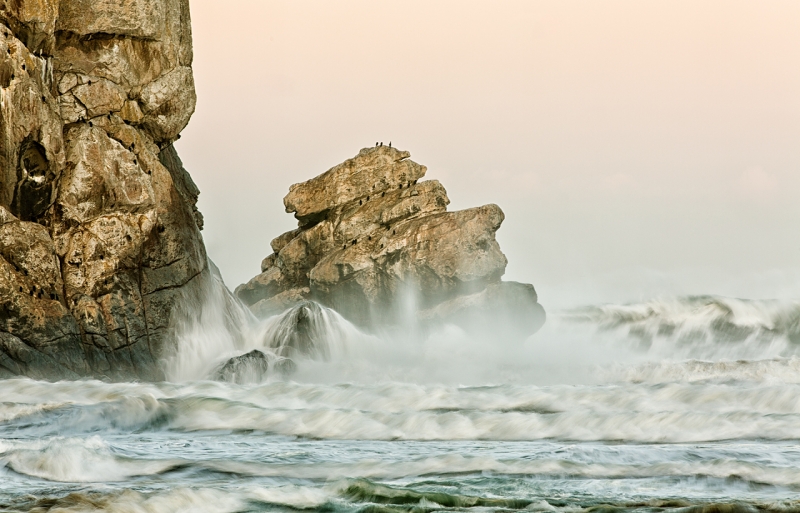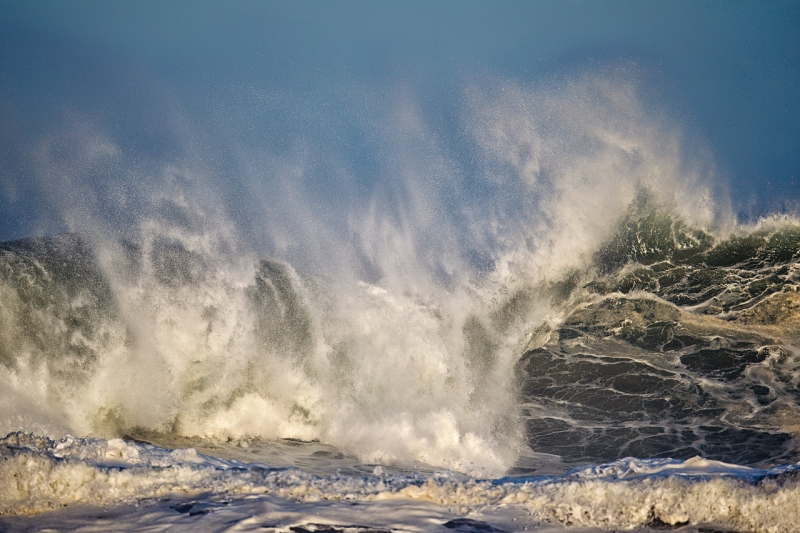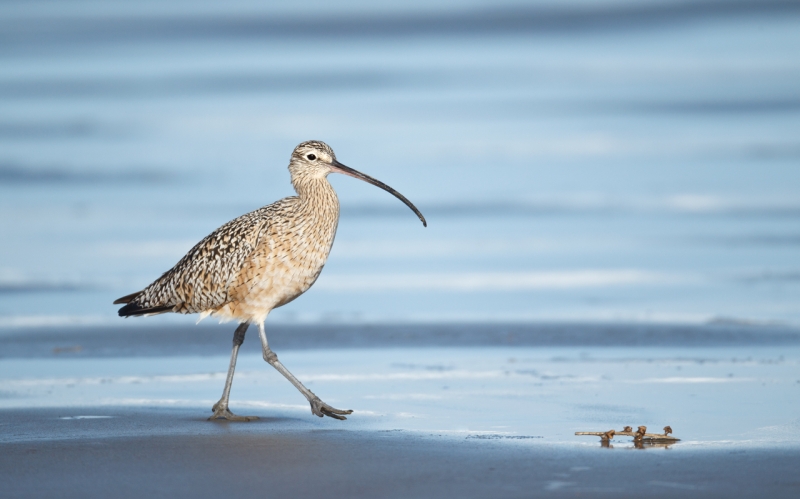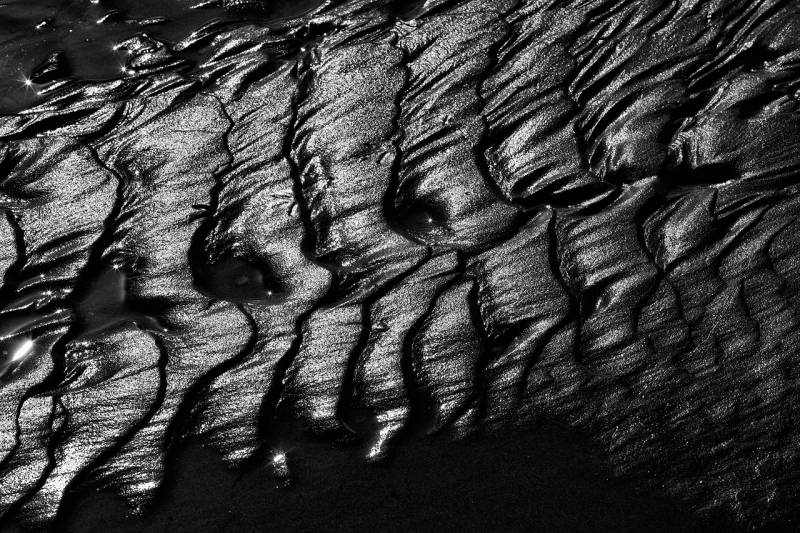|
This image was created with the tripod-mounted Canon 70-200mm f/2.8L IS II lens, the 1.4X III TC (at 280mm), and the Canon EOS-5D Mark III. ISO 100. Evaluative metering at +2 stops: 1/4 sec. at f/4 in Tv mode. Central Sensor–Expand AF area/AI Servo Rear Focus active at the moment of exposure. Click here if you missed the Rear Focus Tutorial. Click on the image to enjoy a larger, more spectacular version. Where do I wish I had pointed the lens. And why??? |
Frozen and Battered
On Sunday morning past I led a Master Class In-the-Field Workshop for the Morro Bay Photo Expo for 15 eager but very cold folks. When I arrived in Morro Bay on Friday afternoon I was shocked at how cold and damp it was. On the morning of the workshop it was clear and cold, 48 degrees to be exact. Though the surf was huge as predicted, things were not too bad. The winds were about 15mph from the west northwest when I created the image above at 6:57am.
|
This image of a huge breaking wave was created at 7:23 am with the with the tripod-mounted Canon 800mm f/5.6L IS lens and the Canon EOS-1D Mark IV. ISO 400. Evaluative metering +1 2/3 stops: 1/800 sec. at f/5.6 in Manual mode. Central Sensor/AI Servo Rear Focus active at the moment of exposure. Click here if you missed the Rear Focus Tutorial. Click on the image to enjoy a larger version. |
With the increasingly strong winds behind them, the waves got bigger just after the sun cleared the hills to the east. Folks estimated the largest waves like this one to be in excess of twenty feet tall.
|
This image was created at 9:03 am with the with the tripod-mounted Canon 800mm f/5.6L IS lens and the Canon EOS-1D Mark IV. ISO 400. Evaluative metering +2/3 stop: 1/1600 sec. at f/5.6 in Manual mode. I used a left sensor/AI Servo Rear Focus that was active at the moment of exposure. Click here if you missed the Rear Focus Tutorial. Click on the image to enjoy a larger version. |
Just after I created the image above the winds really picked up with gusts to 30mph. The birds pretty much disappeared.
|
This image was created with a borrowed Canon 70-200mm f/2.8L IS II lens (hand held at 150mm) and a borrowed EOS-5D Mark II. ISO 100. Evaluative metering +1/3 stop: 1/125 sec. at f/20 in Av mode. All AF points active/shutter button AI Servo AF. Click on the image to enjoy a larger, more spectacular version. NIK Color Efex Pro Tonal Contrast plus NIK Silver Efex Pro High Structure pre-set. |
With no birds around it was time to switch to soup from a stone mode and teach the boys and girls a bit about creative vision when times are tough :). At 10:30 we called it a wrap. The winds continued to increase….
| [Not a valid template] |
|
This image was created at 4:22 pm with the Canon 800mm f/5.L IS lens, the 1.4X III TC, and the Canon EOS-1D Mark IV. ISO 400. Evaluative metering at +1/3 stop: 1/400 sec. at f/10 in Manual mode. Central sensor (by necessity) AI Servo/Rear Focus AF on the kelp which was on the same plane as the otter’s eye active at the moment of exposure. Click here if you missed the Rear Focus Tutorial. |
Having stayed in touch via e-mail with the incoming IPT group I met up with most of them at 3pm. Aidan and I thought that with the strong west winds that the otters might be in close to the road on the inlet side of Morro Rock. And we would be in the lee of the now very strong west wind. Good plan…. But the wind was whipping around the Rock and buffeting us from behind. Everyone was cold. Even when we got low down in the rocks the dirt swirled around and sand-blasted our eyes. It was almost impossible to photograph. Heck, at was almost impossible to stand. Twice I came close to be knocked over when I changed position. And the stronger the wind got the colder I became. When I had visited Morro Bay in 2009 in January it was warm and sunny and with the IPT in spring, I came woefully unprepared clothing-wise…. The sand scoured our hands and all unprotected areas of skin. We estimated gusts of 50 mph or more.
As cute as the otters were we gave up on them just before 5pm and headed for the beach. Even though we were on an open, exposed beach the force of the winds was a bit less as there was no Morro Rock created vortex. Or so it seemed.
With our backs to the wind we had a great afternoon with a pond full of bathing and roosting gulls and a single Long-billed Curlew. We finally quit at 7pm and headed for the motel and the IPT’s introductory slide program at 8pm. Every local whom we talked too the next day stated emphatically that they had never experience the wind and waves of the previous day, even those who had been in the area for forty years. You gotta love it. Monday was sunny and relatively mild.
| [Not a valid template] |
|
This image was created at 6:17 pm with the Canon 800mm f/5.L IS lens and the Canon EOS-5D Mark III. ISO 400. Evaluative metering at zero: 1/2500 sec. at f/5.6 in Manual mode. Central Sensor–Expand AF area/AI Servo Rear Focus active at the moment of exposure. Click here if you missed the Rear Focus Tutorial. Click on the image for a larger version. |
It was a treat to photograph breeding plumage California Gull in the sweet light. At one point a rogue wave driven by the high winds sent all of us running in an effort to keep our boots dry…. It was a fitting end to a very challenging day.
Note: the more I learn about and use my 5D III the more I am loving it.
Earn Free Contest Entries and Support both the Bulletins and the Blog by making all your B & H purchases here.
More and more folks are earning multiple contest entries with their B & H purchases. See here for details on that. Eleven great categories, 34 winning and honored images, and prize pools valued in excess of $20,000. Click here to visit the competition home page.
Shopper’s Guide
Below is a list of the gear used to create the images in today’s post. Thanks a stack to all who have used the Shopper’s Guide links to purchase their gear as a thank you for all the free information that we bring you on the Blog and in the Bulletins. Before you purchase anything be sure to check out the advice in our Shopper’s Guide.
Canon 800mm f/5.6L IS lens. Right now this is my all time favorite super-telephoto lens.
Canon 70-200mm f/2.8L IS II lens. Man, I am loving this lens on my shoulder with the 2XIII teleconverter. I also use it a lot–depending on the situation–with the 1.4X III TC.
Canon EF 1.4X III TC. This new TC is designed to work best with the new Series II super-telephoto lenses.
Canon EOS-5D Mark III. Man, I am in love with this camera body. Both the files and the AF system are superb. I cannot wait to get to Morro Bay.
Canon EOS-1D Mark IV professional digital camera body. The very best professional digital camera body that I have ever used.
And from the BAA On-line Store:
BLUBB. The BLUBB (Big Lens Ultimate BeanBag) is the world’s finest big lens beanbag. There are knock-offs for half the price but you will be wasting your money….
LensCoats. I have a LensCoat on each of my big lenses to protect them from nicks and thus increase their re-sales value. All my big lens LensCoat stuff is in Hardwood Snow pattern.
LegCoat Tripod Leg Covers. I have four tripods active and each has a Hardwood Snow LegCoat on it to help prevent further damage to my tender shoulders 🙂 And you will love them in mega-cold weather….
Gitzo GT3530LS Tripod. This one will last you a lifetime.
Mongoose M3.6 Tripod Head. Right now this is the best tripod head around for use with lenses that weigh less than 9 pounds. For heavier lenses, check out the Wimberley V2 head.
CR-80 Replacement Foot for Canon 800. When using the 800 on a Mongoose as I do, replacing the lens foot with this accessory lets the lens sit like a dog whether pointed up or down and prevents wind-blown spinning of your lens on breezy days by centering the lens directly over the tripod.
Double Bubble Level. You will find one in my camera’s hot shoe whenever I am not using flash.
The Lens Align Mark II. I use the Lens Align Mark II pretty much religiously to micro-adjust all of my gear an average of once a month and always before a major trip. Enjoy our free comprehensive tutorial here.
BreezeBrowser. I do not see how any digital photographer can exist without this program.


















With #1 if you had specifically wanted blurred waves, then less cliff and more sea would have been preferable. But perhaps the shot would have been improved with a 30% shift to the right. The rock texture is great, and the rough sea could be said to be distracting. But I notice you mention the zoom was maxed out, so I’m not too certain how you might improve the image much more. The blur actually seems to give weight to the water. And as you’ve also mentioned about the Cormorants, that gives a nice indication of the scale of the sea.
I love being beside water and could watch it indefinitely. The mid stride Curlew is a great shot. i can recall hearing their calls when I was very young.
Hmm, I’ll bet that Sea Otter was warmer that you guys were. On a cold and windy day, the sea is often a preferable habitat.
In the first picture what kind of birds are on top of the rock and along the side of it?
Cormorants.
Thanks Artie,
I agree more with definition Nr.2, but I understand your interpretation.
Whichever, I always enjoy your stunning pictures.
Ruthie
I far prefer make or create to take. Azizen pesach to you and yours.
Dear Artie,
As you may know I have been receving and admiring your messages for many years and also learned quite a lot to improve my pictures. But something bothers me, the use of the word “created”. it is my opinion that in this respect we do not create, we take the picture which is already there in front of us, and we try to create the best possible reproduction of what we have seen.
I wish you and your family a joyous Pessach,
Ruthie
cre·ate [kree-eyt]
1. to cause to come into being, as something unique that would not naturally evolve or that is not made by ordinary processes.
2. to evolve from one’s own thought or imagination, as a work of art or an invention.